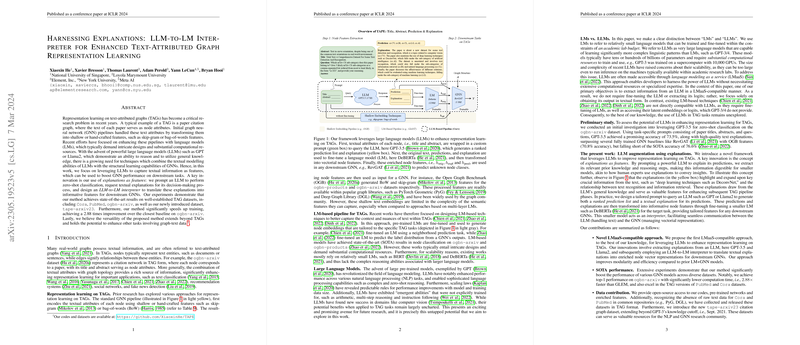Comprehensive Analysis of "Harnessing Explanations: LLM-to-LM Interpreter for Enhanced Text-Attributed Graph Representation Learning"
In "Harnessing Explanations: LLM-to-LM Interpreter for Enhanced Text-Attributed Graph Representation Learning," the authors present a novel approach to augment representation learning in text-attributed graphs (TAGs) by integrating LLMs into the graph neural network (GNN) pipeline. This paper addresses the growing need for techniques that effectively combine the textual modeling capabilities of LLMs with the structural learning prowess of GNNs.
Core Contribution
The paper introduces a framework that leverages LLMs to capture textual information in TAGs and transforms them into features to enhance GNN performance on downstream tasks. A key innovation is the use of LLM-extracted explanations as features. By utilizing LLMs such as GPT to perform zero-shot classifications and requesting textual explanations for these decisions, the authors propose an LLM-to-LM interpreter designed to translate these explanations into valuable features for subsequent GNN processing.
Experimental Strength and Results
The authors evaluate their framework across well-established TAG datasets like Cora, PubMed, ogbn-arxiv, and the newly introduced tape-arxiv23 dataset. Their method achieves state-of-the-art results, demonstrating significant improvements in accuracy and efficiency. For example, the framework achieves a 73.5% accuracy on the ogbn-arxiv dataset using GPT-3.5 for zero-shot classification, a notable feat when compared to the SOTA model's accuracy of 76.6%. Their approach also improves training efficiency, achieving a 2.88 times speed-up over the closest baseline on ogbn-arxiv.
Theoretical Implications and Practical Applications
The method's versatility is a central theme, with implications extending beyond TAG tasks such as text classification, recommendation systems, and social networks. The process of transforming textual explanations from LLMs into AGN-compatible node representations underscores the innovative use of LLM outputs in static graph tasks. Moreover, the proposed framework addresses scalability concerns with LLMs, allowing efficient usage via LLMing as a service (LMaaS), thus bypassing the computational challenges often associated with LLM inference.
Future Prospects
Looking ahead, automated prompt generation for LLM-to-LM tasks and further exploration of LLM scalability are promising avenues for refinement. This paper opens new pathways by utilizing LLM explanations—not just raw textual outputs—potentially applicable to evolving tasks in dynamic and large-scale TAGs.
Conclusion
The work significantly advances representation learning for TAGs by merging cutting-edge LLM capabilities with the structural learning strengths of GNNs, establishing a robust baseline for future research endeavors. The approach provides a noteworthy enhancement to modeling TAGs, streamlining complex reasoning into practical feature sets for GNNs. As such, the methodology stands as a crucial contribution to the field, promising to influence future methodologies in integrating language-processing models with graph-based learning systems.
